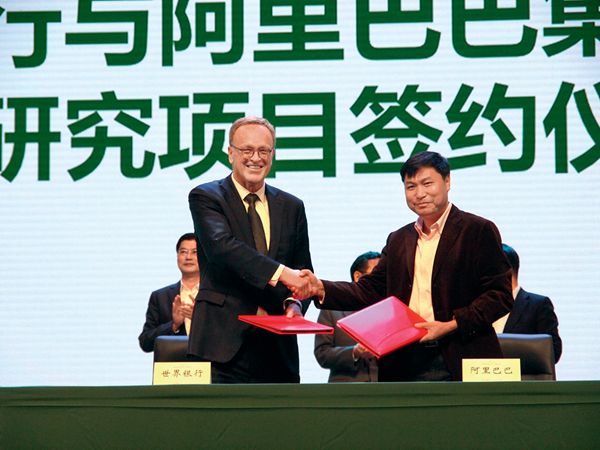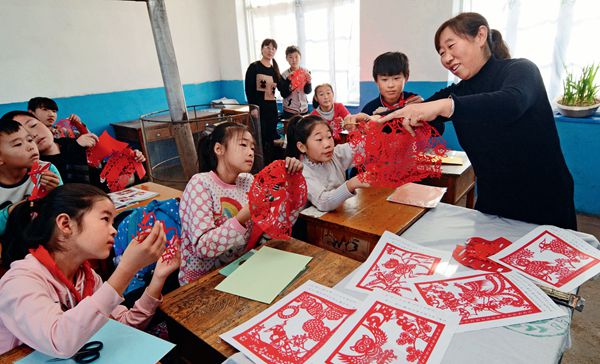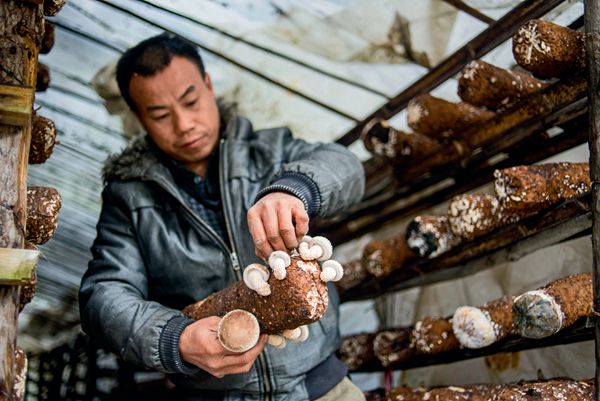By XU LIN
By XU LIN
Since the early 1980s, 800 million people have been lifted out of poverty in China,” said Bert Hofman, the World Bank’s Country Director for China, Mongolia and Korea. “At present, the country has a relatively low poverty share of 55 million people according to the local poverty calculation. However, the proportion is even lower when measured by international standards. So China is a very successful example in this regard.”

The World Bank and Alibaba sign an agreement in October 2016 on cooperative research into the Taobao village phenomenon in efforts to discover why some villages are successful and others are not.
The World Bank released a new report on global poverty reduction last October before the International Day for the Eradication of Poverty, 2016. “This report focuses on poverty reduction and shared prosperity,” Mr. Hofman explained. “Both poverty reduction and equality are goals of the World Bank. Poverty reduction is also an important part of the UN’s Sustainable Development Goals.” He went on to say: “Poverty alleviation has done very well over the last 25 years. In 1990, about 35 percent of the world’s population was below the international poverty line, but today it is less than 10 percent. China has been playing a key role in this respect.”
Economic Growth Plays Key Role
China has contributed to almost 70 percent of global poverty reduction. According to Mr. Hofman, economic growth is the main reason for China’s poverty reduction. He is quite familiar with the history of China’s economic development and the efforts the country has made to alleviate poverty.
“Overall growth has been very high over the last 35 years in China, with an average annual growth rate of more than nine percent, which means many people can find new jobs, better jobs, and more productive jobs. Therefore, they can lift themselves from poverty. It happens because of the reform in the economic system.” Mr. Hofman noted that the reform process began in agriculture. The introduction of the household contract responsibility system at the end of the 1970s was a tremendous boost for poverty reduction. But, he believes, the reforms went beyond that – urban reforms, the socialist market economy, and China’s entry into the World Trade Organization all played important roles. “China has opened up and urbanized quite rapidly, becoming the world’s manufacturing hub. That means a lot of people have moved from rural areas to urban areas. This allows people to find more productive jobs, moving from agriculture to manufacturing and services with increased income.”
Policy also plays a significant role. Policies on education are very important in enabling people to change their lives. In addition, China has built a lot of infrastructure which means cities can grow, and the economic system is increasingly supported by the private sector.

Daxue Village in Liaoning Province highlights education as a crucial part of targeted poverty alleviation.
Mr. Hofman stressed that other countries cannot simply “copy” China’s method of poverty reduction, because China has forged its own unique path to development tailored to its specific circumstances. Still, some parts of China’s experience are worth examining. Mr. Hofman pointed out: “It’s very important to start from agriculture. Most of the poor in other countries also live in rural areas and are engaged in agriculture. Some of them face similar constraints as China did. Strengthening property rights of farmers – that’s what the household contract responsibility system did – actually gives farmers more ownership to the land. People invest more in the land and they work harder, which increases productivity. China has done very well in investing in people. It makes sure that people have the capabilities to benefit from the economic growth that happens through reforms. Other countries can learn from that.”
According to Hofman, China has made a concerted effort in targeted poverty reduction. “The State Council Leading Group Office of Poverty Alleviation and Development which we’ve been working with for many years is a phenomenal institution. The presence of such an organization meant that there’s a real focus on the issue of poverty. They developed targeted poverty programs that evolved over time – first in poor areas, but increasingly also with poor people so that they could help those who could not benefit from the general growth to get out of poverty themselves.”

Wu Laojiang, a young disabled man in Guizhou Province, started a mushroom production venture with the help of local poverty relief projects.
In December 2015, China set itself a goal to lift the remaining 55 million poor people out of poverty by 2020. Mr. Hofman thinks it is an ambitious goal, but he believes that China can achieve it if continues with its current growth rates and policies. However, it is not the end goal since there are many more people that live slightly above the poverty line and can still be considered “poor.” He further pointed out that China should continue investing in poor people to make sure that their education, health, and insurance systems are up-to-date. In his words: “Health and the cost of health are actually important causes of poverty in the country.”
Cooperation Mode Constantly Reorients
The World Bank and China have had a long and productive cooperation in poverty reduction. While it has witnessed the progress of China’s efforts in poverty alleviation, the organization constantly reorients its mode of cooperation in accordance with the direction the development is taking. Mr. Hofman revealed that in addition to working on projects, the World Bank has done three major poverty reviews which provided the analytical basis with which to design the next phase of poverty reduction programs.
The first generation program in China, according to Hofman, was very much aligned with the then situation more than 25 years ago. “There were many poor counties, most of which relied on agriculture. So we invested in agricultural infrastructure and in helping farmers get right fertilizers, seeds, and education to ensure they could absorb modern techniques.” But today, personal background and characteristics are much more determinate of poverty. “It matters far less where you live and whether you are poor or not than what your personal characteristics are,” he explained, “whether you have somebody in the family who works, whether you have got a good education, whether you have nobody sick in the family. Hence, the poverty programs have also changed.”
On top of this, China has modernized tremendously, so the World Bank is looking at very different kinds of programs. “One of the programs that we do together with the State Council Leading Group Office of Poverty Alleviation and Development, is to use agricultural collectives as a means to reach out to those poor people that are not yet connected to the modern economy,” said Mr. Hofman. “We tie them up to the modern supply chain to help them get more money for their goods and upgrade their quality standard of agricultural products that they are bringing to the market.” The organization has also been looking at the remaining poor in China. “Some of them are living in very remote areas with very little basis for economic production. Therefore, helping those people move is another important element of more modern poverty reduction efforts.” Hofman showed that the World Bank is currently discussing whether these measures should be introduced into its current poverty alleviation programs.
However, Mr. Hofman stressed that there will still be poor people even when those remaining have been lifted out of poverty. The disabled, for example, will always need assistance. He sees the basic living allowance system in China as a social safety net and an essential tool keeping people out of poverty. “The redesign of the system is meant to be very important in the medium run,” he said.
ICT to Play Larger Role
Last May, the Global Poverty Reduction and Inclusive Growth portal was jointly launched by the China Internet Information Center and the International Poverty Reduction Center in China. Supported by the World Bank and the Asian Development Bank, the portal aims at sharing knowledge of poverty reduction and the most effective methods used in China and around the world.
Mr. Hofman was present at the launch of the portal, which he considers to be a major step forward in poverty alleviation. “Information and communication technology (ICT) can play a bigger role in poverty reduction,” he stated. “One aspect of it refers to access to finance. Finance and ICT are a tremendously strong combination that makes it easier for the poor in remote areas to get a credit.” Meantime, e-commerce is another element that the World Bank is looking at. Today, people in isolated villages are able to get market information and tie into modern supply chains through e-commerce. Mr. Hofman took the Alibaba villages as an example. Driven by a booming online retail market led by China’s e-commerce giant Alibaba, some small villages in eastern China have reinvented themselves as hotspots for e-business. “These famous villages are largely in some of the richer parts of the country. But we are now working with Alibaba to study how these villages actually emerged and if we can use that model for poor villages in the hinterland in the western part of the country,” Mr. Hofman said. He believes this is a great opportunity for e-commerce to become a vehicle for people to escape from poverty.
XU LIN is a reporter with china.com.cn